- No annual fee.
- 5% cash back on up to $500 per billing cycle in your top spending category.
Our evaluations and opinions are not influenced by our advertising relationships, but we may earn a commission from our partners’ links. This content is created independently from TIME’s editorial staff. Learn more about it.
Not all cash back credit cards are created equal. From varying welcome bonuses to differing earning rates to ongoing benefits, finding the perfect cash back credit card for you is more intricate than you might think.
TIME Stamped shortens the process. We’ve compared these elements on all cash back credit cards and distilled your options down to each major cardholder profile. Whether the lion’s share of your spending is on dining, groceries, gas, or online shopping, we’ve identified the best credit cards for your style.
Best cash back credit cards: Summary
- Best for 5% cash back: Citi Custom Cash® Card
- Best flat-rate cash back: Citi Double Cash® Card
- Best for a large sign-up bonus: Ink Business Cash® Credit Card
- Best for dining: Capital One SavorOne Cash Rewards for Good Credit
- Best for business: Ink Business Unlimited® Credit Card
- Best for utility bills: U.S. Bank Cash+® Visa Signature® Card
- Best for excellent credit: Capital One Quicksilver Cash Rewards Credit Card
- Best for groceries: Blue Cash Preferred® Card from American Express
- Best for gas: Costco Anywhere Visa® Card by Citi
- Best for online shopping: Prime Visa
- Best for no annual fee: Chase Freedom Flex℠
- Best for students: FirstCard
- Best choose-your-own bonus categories: Bank of America® Customized Cash Rewards Credit Card
- Best for poor credit: Discover it® Secured Credit Card
- Best for cellphone insurance: Wells Fargo Active Cash® Car
Why we recommend these cash back credit cards
Best for 5% cash back: Citi Custom Cash® Card
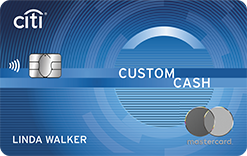
Citi Custom Cash® Card
Citi Custom Cash® Card
Welcome bonus. Earn $200 in cash back after you spend $1500 on purchases in the first 6 months of account opening. This bonus offer will be fulfilled as 20,000 ThankYou® points, which can be redeemed for $200 cash back.
Special Travel Offer. Earn an additional 4% cash back on hotels, car rentals, and attractions booked on Citi Travel℠ portal through 6/30/2025.
Why we chose it. The Citi Custom Cash® Card is hands down the easiest to use 5% back credit card on the market. Here’s how it works.
You’ll get 5% cash back on up to $500 spent in your top spending category per billing cycle, then 1% thereafter. Eligible spending categories are:
- Drugstores
- Fitness clubs
- Gas stations
- Grocery stores
- Home improvement stores
- Live entertainment
- Restaurants
- Select streaming services (including Netflix, Hulu, Amazon Prime Video, Spotify, YouTube TV, and many more)
- Select transit
- Select travel
You’ll earn 1% cash back on all other eligible purchases.
This takes much of the strategy away from earning a boatload of credit card rewards. Simply spend as you normally would, and whichever above category you use the most will receive a 5% bonus. Five hundred dollars in eligible spending per billing cycle means you could earn a potential $300 back each year with virtually no effort.
This card earns Citi ThankYou points, which you can redeem for 1 cent each. If you’ve got either the Citi Premier® Card or the Citi Prestige® Card (not available to new applicants), you can move those points to airline and hotel partners for free travel—and potentially get a value far greater than 1 cent per point.
Pros:
Cons:
- Need the Citi Premier® Card or the Citi Prestige® Card to use the card for travel.
Learn more from our full review.
Best flat-rate cash back: Citi Double Cash® Card
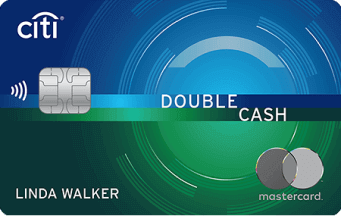
Citi Double Cash® Card
Citi Double Cash® Card
Welcome bonus. Earn $200 cash back after you spend $1,500 on purchases in the first 6 months of account opening. This bonus offer will be fulfilled as 20,000 ThankYou® Points, which can be redeemed for $200 cash back.
Why we chose it. The best flat-rate cash back is the Citi Double Cash® Card. There are two ways you can use it to reward yourself when spending.
First, the card earns 1% back when you make a purchase and 1% back when you pay off that purchase. Expenses are usually wide-ranging, with very few falling into common bonus categories. The Citi Double Cash® Card will effectively earn 2% back on everything. If you funnel your expenses through this card, you’re guaranteed to get a respectable return.
Second, the card offers balance_transfer_intro_apr,balance_transfer_intro_duration (followed by an reg_apr,reg_apr_type rate). This is notably more generous than other cash back credit cards.
For those planning a big event, a wise strategy is to open a couple of credit cards offering juicy welcome bonuses. You could quite easily earn more than $1,000 in rewards. You could then transfer those balances to the Citi Double Cash® Card and have 18 months to pay off your expenses before any interest kicks in.
Pros:
- No annual fee.
- 0% introductory APR for 18 months.
- Effective 2% unlimited cash back on all purchases.
Learn more from our full review.
Best for a large sign-up bonus: Ink Business Cash® Card

Ink Business Cash® Card
Ink Business Cash® Card
Why we like it:
Welcome bonus. Earn $350 when you spend $3,000 on purchases in the first three months and an additional $400 when you spend $6,000 on purchases in the first six months after account opening.
- Earn $350 after spending $3,000 on purchases with the first three months from account opening.
- Earn an additional $400 after spending a total of $6,000 on purchases within the first six months from account opening.
Plus, those with a Chase Business Checking account will receive a one-time 10% bonus on all the cash back earned during the first cardmember year. For example, If you earn a total of $1,000 in cash back during the first year, you’ll get another $100 at the end of your anniversary year. (Note that this bonus is just for cards opened between March and November 2024.)
Why we chose it. You won’t find a larger welcome bonus from a no-annual-fee credit card than the Ink Business Cash® Card. In fact, this bonus is even larger than most cards that charge annual fees.
This card also earns:
- 5% cash back (5x points) at office supply stores and on internet, cable, and phone services
- 2% cash back (2x points) at gas stations and restaurants
- 1% cash back (1x points) on all other purchases
For the 5% and 2% categories, you’ll only earn bonus cash on up to $25,000 in combined spending, then 1%.
Instead of earning cash, this card actually earns Chase Ultimate Rewards points, which can be redeemed for 1 cent each. Or, if you have a card such as the Chase Sapphire Preferred® Card, Chase Sapphire Reserve®, or Ink Business Preferred® Credit Card, you can transfer those points to travel partners, such as Hyatt and Southwest, for free travel.
Pros:
- No annual fee.
- Generous sign-up bonus.
- Chase Business checking account holders have a one-time 10% bonus on cashback earned in the first year.
- 5% cash back on many business expenses.
- Card earns Chase Ultimate Rewards® points, potentially redeemable for travel.
Cons:
- Must hold a Chase Ultimate Rewards card (which charges a fee) to use Ultimate Rewards points.
- $25,000 limit in combined spending for top bonus categories.
- No 0% APR offer.
Best for dining: Capital One® SavorOne® Cash Rewards Credit Card
Capital One® SavorOne® Cash Rewards Credit Card
Capital One® SavorOne® Cash Rewards Credit Card
Welcome bonus. $200 Cash Back after you spend $500 on purchases within 3 months from account opening.
Why we chose it. The Capital One SavorOne Cash Rewards Credit Card was engineered for food purchases. Not only will you receive a whopping 4% back at restaurants (and even some food delivery services), but you’ll get 3% back at grocery stores for when you prefer to make your own culinary masterpiece. You’ll even receive 10% back on Uber Eats (and Uber) purchases—and free Uber One membership—through Nov. 14, 2024.
The card is no slouch in other common categories as well:
- 8% back via Capital One Entertainment
- 5% back for hotels and car rentals reserved through Capital One Travel
- 4% back on entertainment
- 4% back on popular streaming services
- 1% back on all other purchases
Just remember the card’s $0 annual fee. You may be earning significantly more cash back for your everyday purchases than other no-annual-fee credit cards, but the annual fee may negate a lot of your cash back.
Also of note is that this card gives you access to Capital One Dining, a platform that helps you to book reservations at restaurants that are otherwise extremely difficult to get.
Even though this card earns cash back, you can turn your rewards into Capital One miles if you also have a Capital One miles-earning card, such as the Capital One® SavorOne® Cash Rewards Credit Card. From there you can transfer them to airline and hotel partners for free travel.
Pros:
- $300 welcome bonus.
- Generous 4% back on dining and 10% on Uber and Uber Eats.
- Very generous entertainment and hotel bonuses.
- Access to Capital One Dining.
Cons:
- $95 annual fee.
- To turn rewards to miles you need a Capital One miles-earning card.
- No 0% APR offer.
- Need to have excellent credit.
Best for business: Ink Business Unlimited® Credit Card
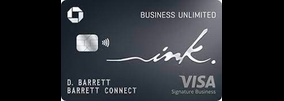
Ink Business Unlimited® Credit Card
Ink Business Unlimited® Credit Card
- 1.5% cash back on every business-related purchase
- 5% cash back on Lyft (through March 2025)
Why we like it:
Welcome bonus. Earn $750 bonus cash back after you spend $6,000 on purchases in the first 3 months from account opening.
Why we chose it. The Ink Business Unlimited® Credit Card is the best small business cash back credit card for most businesses because it earns a flat 1.5% back for all purchases. That makes it useful for all types of businesses instead of just those with spending that falls into what are often niche bonus categories.
This card earns Chase Ultimate Rewards points—not cash. You can redeem your points for 1 cent each. Or, if you also hold an Ultimate Rewards–earning card, such as the Chase Sapphire Preferred® Card, you can turn your rewards into airline miles or hotel points for free travel.
Because this is a small business credit card, you’ll need to own a small business to qualify. But even a side gig as simple as delivering food with DoorDash, freelance writing, or tutoring is considered a small business.
Pros:
- $750 welcome bonus.
- Flat 1.5% cash back for all purchases
- Card earns Chase Ultimate Rewards® points, potentially redeemable for travel.
Cons:
- Must hold a Chase Ultimate Rewards card (which charges a fee) to use Ultimate Rewards points.
- No 0% APR offer.
Best for utility bills: U.S. Bank Cash+® Visa Signature® Card
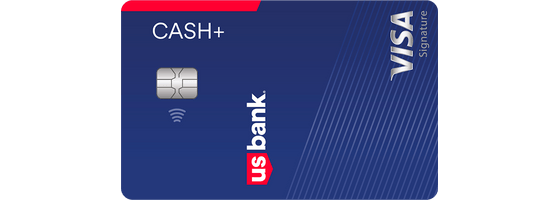
U.S. Bank Cash+® Visa Signature® Card
U.S. Bank Cash+® Visa Signature® Card
Welcome bonus. Earn a $200 bonus after you spend $1,000 in eligible purchases within the first 120 days of account opening.
Why we chose it. The U.S. Bank Cash+® Visa Signature® Card is a choose-your-own-adventure card. Each quarter you can select two eligible categories with which you want to earn bonus rewards. Eligible categories are:
- Cellphone providers
- Department stores
- Electronic stores
- Fast food
- Furniture stores
- Ground transportation
- Gyms and fitness centers
- Home utilities
- Movie theaters
- Sporting goods stores
- Select clothing stores
- TV/internet/streaming purchases
The option to earn up to 5% bonus rewards on home utilities is extremely rare among rewards credit cards.
The card also earns unlimited 5% back for any travel reserved through the U.S. Bank Rewards Travel Center. You'll earn 1% cash back on all other purchases. Additionally, you can choose one category for which you’d like to earn 2% back: gas/EV charging stations, grocery stores (including delivery), or restaurants.
Pros:
- No annual fee.
- $200 welcome bonus.
- o% APR for the first 15 billing cycles.
- Can choose two categories per quarter for 5% cash back, including utilities
- Can choose additional 2% cash back category
Cons:
- $2,000 limit on combined 5% cash back spending.
Best for excellent credit: Capital One QuicksilverOne Cash Rewards Credit Card
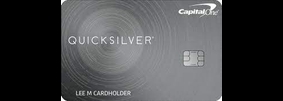
Capital One QuicksilverOne Cash Rewards Credit Card
Capital One QuicksilverOne Cash Rewards Credit Card
Welcome bonus. One-time $200 cash bonus after you spend $500 on purchases within 3 months from account opening.
Why we chose it. The Capital One Quicksilver Cash Rewards Credit Card is, per Capital One, only for those with excellent credit. The card earns:
- 5% back on hotels and car rentals reserved through Capital One Travel
- 1.5% back on all other eligible purchases
No personal Capital One–branded cash back credit card offers a higher flat rate for all spending. It’s a great option if your spending doesn’t conform to standard bonus categories.
Similar to other Capital One credit cards, you can turn these rewards into Capital One miles. All you need is a Capital One miles-earning card, such as the Capital One Venture Rewards Credit Card, and you’re free to transfer your rewards to partners such as Air Canada Aeroplan, British Airways, Wyndham, and more.
This card also offers a few travel and purchase insurances, no foreign transaction fees, and up to six months of free Uber One membership (in the form of statement credits) through Nov. 14, 2024.
Pros:
- No annual fee.
- $200 welcome bonus.
- 5% cash back on hotels and car rentals.
- 1.5% cash back on everything else.
- Other travel benefits and free Uber One membership for up to six months.
Cons:
- Need to have excellent credit.
- To turn rewards to miles you need a Capital One miles-earning card.
Best for groceries: Blue Cash Preferred® Card from American Express*
Blue Cash Preferred® Card from American Express
Blue Cash Preferred® Card from American Express
Welcome bonus. Earn a $250 statement credit after you spend $3,000 in purchases on your new Card within the first 6 months.
Why we chose it. The $0 intro annual fee for the first year, then $95. annual fee Blue Cash Preferred® Card from American Express vanquishes all challengers in a couple of popular spending categories. Here’s what you’ll get.
- 6% cash back at U.S. supermarkets on up to $6,000 in spending per year, then 1% (Amex does not consider superstores, convenience stores, warehouse clubs, and meal-kit delivery services to be supermarkets)
- 6% back on select U.S. streaming subscriptions
- 3% back at U.S. gas stations (1% back at superstores, supermarkets, and warehouse clubs that sell gasoline)
- 3% back on transit
- 1% back on all other purchases
Earning 6% back on groceries makes this one of the best Amex credit cards for families. With a $6,000 cap, your potential bonus earnings amount to $360 per year. Even a household of moderate size should be able to achieve that by spending $500 per month on groceries.
This card even comes with two monthly statement credits:
- $7 credit to reimburse a subscription to the Disney Bundle costing $12.99 or more per month (enrollment required).
- $10 credit to offset Equinox+, an online workout subscription that costs $40 per month (enrollment required).
You can also take advantage of a 0% on purchases 12 months (then 19.24% - 29.99% Variable).
Pros:
- ‌bonus_miles welcome bonus.
- 6% cash back up to $6,000 for supermarket purchases, select streaming purchases.
- 3% transit credits (gas, transit).
- $17 in statement credits for Disney Bundle/Equinox+ subscription.
- ‌intro_apr_rate,intro_apr_duration.
Cons:
- ‌annual_fees annual fee.
Best for gas: Costco Anywhere Visa® Card by Citi

Costco Anywhere Visa® Card by Citi
Costco Anywhere Visa® Card by Citi
Welcome bonus. The Costco Anywhere Visa® Card by Citi doesn’t offer a public intro offer. However, you can inquire in-store to see whether you are targeted for a bonus.
Why we chose it. The Costco Anywhere Visa® Card by Citi offers a high return for filling up your vehicle. You’ll earn 4% back on gas and EV charging stations worldwide (up to $7,000 in spending per year, then 1%).
While you don’t have to fill up at Costco to get a 4% return, there are some stipulations: Any gas purchased at a supermarket, superstore, convenience store, or warehouse club (with the exception of Costco) will only earn 1% back.
This card also earns:
- 3% cash back with restaurants
- 3% cash back for eligible travel purchases worldwide
- 2% cash back for all other purchases from Costco (in-store and online)
- 1% cash back on all other eligible purchases
The big annoyance with this card’s cash back is that you can only redeem it once per year after your February billing statement closes. You can use it for cash or for merchandise at Costco warehouses in the U.S. In other words, you can’t redeem your cash back throughout the year as you can with other cash back cards.
Pros:
- No annual fee.
- Very generous cash back on gas (4% up to $7,000).
- Good cash back on restaurants, eligible travel purchases (3%) and other Costco purchases (2%).
Cons:
- May have no welcome bonus.
- Limitations on where you can buy gas to get the bonus.
- Can only redeem cash back once a year.
- No 0% APR offer.
- Need to have excellent credit.
Best for online shopping: Prime Visa

Prime Visa
Prime Visa
Why we like it:
Welcome bonus. Get a $100 Amazon Gift Card instantly upon approval exclusively for Prime members plus 5% cash back on all purchases (up to $2,500 in spending) for three months after account opening.
Why we chose it. There are a handful of credit cards that specifically pair bonus spending with online retailers. However, the fact that the Prime Visa offers 5% back with Amazon—a place where you can get just about anything—makes this card the superior choice for most online shoppers. Here’s a full rundown of what the card earns.
- 5% back at Amazon and Whole Foods
- 5% back on travel booked through the Chase Travel Portal
- 2% back with restaurants, gas stations, and local transit and commuting (such as Uber)
- 1% back on all other eligible purchases
This card also unlocks a limited-time 10% return (and sometimes more) for select products.
There’s one big caveat with the Prime Visa card: While it technically doesn’t charge an annual fee, you’ll only receive 5% back on Amazon and Whole Foods if you’ve got Amazon Prime, which costs $139 per year. If you aren’t a Prime member, you’ll earn 3% in these categories.
Pros:
- No annual fee.
- Welcome bonus at Amazon.
- Generous 5% cash back at Amazon and Whole Foods, plus travel booked through Chase Travel Portal.
- Limited 10% return on some purchases.
Cons:
- Cash back drops to 3% if you aren’t an Amazon Prime member.
- No 0% APR offer.
Best for no annual fee: Chase Freedom Flex℠
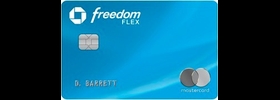
Chase Freedom Flex℠
Chase Freedom Flex℠
Why we like it:
Welcome bonus. Earn a $200 Bonus after you spend $500 on purchases in your first 3 months from account opening!
Why we chose it. The Chase Freedom Flex℠ is one of the most versatile cash back credit cards in the industry for multiple reasons. The fact that it doesn’t charge an annual fee is an additional plus.
First, there are the card’s earning rates. You’ll earn 5% back in rotating bonus categories (for up to $1,500 in purchases each quarter, then 1%) after you activate.
You’ll also earn:
- 5% back for travel reserved through the Chase Chase Ultimate Rewards®
- 3% back for dining and drugstore purchases
- 1% back on all other purchases
Even better, the card technically earns Chase Ultimate Rewards® points—not cash back. You’re free to redeem your rewards for cash at a rate of 1 cent per point, but if you also hold an annual fee-incurring Ultimate Rewards card, such as the Chase Sapphire Preferred® Card, you can convert those rewards into airline miles and hotel points with Chase transfer partners for free travel. This potentially gives you far more value than just 1 cent per point.
The Chase Freedom Flex℠ is a great way to accrue travel rewards if you’re not quite ready to spring for a credit card with an annual fee. Then, when you’re ready to open a travel credit card such as the Chase Sapphire Preferred® Card, you’ll already have a stockpile of points at your disposal.
Pros:
- No annual fee.
- Offers welcome bonus.
- 5% cash back on rotating categories (up to $1,500).
- Card earns Chase Ultimate Rewards® points, potentially redeemable for travel.
Cons:
- Must hold a Chase Ultimate Rewards card (which charges a fee) to use Ultimate Rewards points.
- Purchases in most categories only earn 1%.
- No 0% APR offer.
Best for students: Firstcard
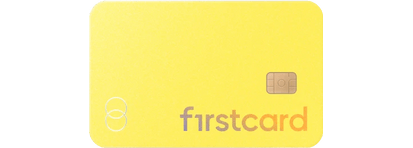
Firstcard
Firstcard
Firstcard is a debit card-esque flavor of student credit card. It can give those with bad (or no) credit history a chance to exhibit healthy credit behavior and produce a good credit score.
When you open the Firstcard, you’ll also open a linked bank account. The amount of money you deposit into your bank account will be the size of your credit limit—that’s how it makes sure you don’t spend more than you’ve got. You can instantly change the size of your credit limit by withdrawing or depositing money into your linked account.
When you spend on the card, you’ll earn up to 15% cash back at participating merchants. You’ll also earn cash back for all other purchases. After each purchase, you’ll have the opportunity to spin a virtual wheel within the Firstcard app to earn between 0.1% and 10%.
Firstcard doesn’t run your credit, so anyone (even international students) can open the card. It also doesn’t charge an annual fee, late payments, or interest.
Pros:
- No annual fee.
- Helps you build your credit score.
- Earn up to 15% cash back at participating merchants
- Earn variable cash back, using the app.
- Payment reported to credit agencies.
Cons:
- Need to open a linked bank account that determines your credit limit.
- No 0% APR intro offer.
- Charges a $2.50 fee to use an ATM.
Best choose-your-own bonus categories: Bank of America® Customized Cash Rewards Credit Card
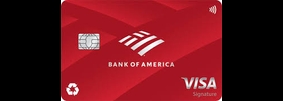
Bank of America® Customized Cash Rewards Credit Card
Bank of America® Customized Cash Rewards Credit Card
Welcome bonus. $200 online cash rewards bonus after you make at least $1,000 in purchases in the first 90 days of account opening.
Why we chose it. An increasingly popular genre of credit card is one that allows you to select the bonus category (or categories) that best complement your spending habits. The no-annual-fee Bank of America® Customized Cash Rewards Credit Card is among the best of these types of cards, giving you 3% cash back in any one of the following categories:
- Gas/EV charging stations.
- Dining.
- Drug stores and pharmacies.
- Online shopping—including cable, internet, phone plans, and streaming.
- Home improvement and furnishings.
- Travel.
You can change your preferred category once per month. The card also earns 2% back at grocery stores and wholesale clubs and 1% back everywhere else. And if you’ve got Bank of America Preferred Rewards status (earned from keeping at least $20,000 in qualifying deposits with Bank of America and Merrill), you could get between a 25% and 75% bonus on the rewards you earn. That means you could earn up to 5.25% with this card.
There’s just one caveat: Your combined spending in 3% and 2% categories are capped at $2,500 in quarterly spending (an average of $833 per month). After that, you’ll earn 1% cash back.
Pros:
- No annual fee.
- Pick the bonus category that best suits your spending.
- Sizable welcome bonus for a no annual fee credit card.
Cons:
- Bonus cash back is capped each quarter.
- You must have significant qualifying deposits with Bank of America to earn the maximum amount of rewards.
Best for poor credit: Discover it® Secured Credit Card
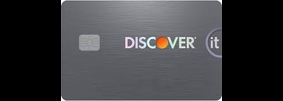
Discover it® Secured Credit Card
Discover it® Secured Credit Card
Welcome bonus. Discover will match all the cash back you've earned at the end of your first year.
Why we chose it. If your credit score is limited or poor (think below 600), you’ll have a hard time being approved for the vast majority of cash back credit cards. The cards that are designed for those with less-than-perfect credit tend not to offer rewards; the biggest carrot with these sorts of cards is the fact that you can use them to improve your credit profile — so you can eventually open cards that do offer rewards.
The Discover it® Secured Credit Card a cash back credit card that gives folks with underwhelming credit a chance. Opening the card requires a refundable security deposit. The size of your credit limit is proportional to the amount of money you deposit. Then, when you cancel or product-change to an unsecured card, you’ll get that money back.
The Discover it Secured Card earns 2% cash back at gas stations and restaurants (up to $1,000 in combined spending each quarter, then 1%). It earns 1% cash back on everything else. Plus, Discover will match the cash back you earn during your first 12 months — effectively giving you 2% to 4% back on all purchases.
Pros:
- No annual fee.
- Low approval standards.
- Up to 4% cash back during your first year.
Cons:
- Cash back bonus categories are capped each quarter.
- You must submit a refundable security deposit.
Best for cellphone insurance: Wells Fargo Active Cash® Card
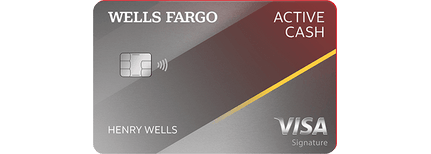
Wells Fargo Active Cash® Card
Wells Fargo Active Cash® Card
Welcome bonus. Earn a $200 cash rewards bonus after spending $500 in purchases in the first 3 months.
Why we chose it. The Wells Fargo Active Cash® Card earns an uncapped 2% back on all purchases, making it one of the best rewards credit cards for those with transactions that don’t typically fall into a credit card bonus category. Expenses like auto repairs and medical bills will almost never receive bonus cash—so using a card that earns a flat 2% everywhere is your best bet.
Additionally, the Wells Fargo Active Cash comes with a perk that you won’t find on many no annual fee credit cards: You’ll get up to $600 in automatic cellphone coverage when you use your card to pay your phone bill (maximum two claims per 12-month period). You’ll only pay a $25 deductible.
Pros:
- No annual fee.
- Solid earning rate on all purchases.
- Excellent cellphone insurance.
Cons:
- Incurs foreign transaction fees.
- No bonus categories.
Best cash back credit cards comparison chart
| Card name | Annual fees | Credit score needed | Bonus rewards |
|---|---|---|---|
Excellent, Good, Fair | Earn $200 in cash back | ||
Excellent, Good, Fair | Earn $200 cash back | ||
$0 | Excellent, Good | Earn $350 when you spend $3,000 on purchases in the first three months and an additional $400 | |
$0 | Excellent, Good | $200 Cash Back | |
$0 | Excellent, Good | Earn $750 bonus cash back | |
$0 | Good, Excellent | $200 bonus | |
$0 | Good | N/A | |
$0 intro annual fee for the first year, then $95. | Good, Excellent | Earn a $250 statement credit | |
$0 | Excellent | N/A | |
$0 | Excellent, Good | Get a $100 Amazon Gift Card | |
$0 | Excellent, Good | $200 bonus | |
$0 | Any | N/A | |
$0 | Good, Excellent | $200 online cash rewards | |
$0 | Poor | Match you cash back during first year | |
$0 | Good, Excellent | $200 cash rewards |
Our methodology
We examined all cash back credit cards to determine which is the best fit for multiple different lifestyles. The features we compared were:
- Annual fee. Does the card charge an annual fee? Are its benefits and earning rate worth the money?
- Earning rate. How accessible are the card’s bonus categories? Are the return rates more impressive than competing cash back credit cards?
- Ongoing benefits. Do the cards have benefits that can effectively put cash back in the pocket of the average cardholder?
- Welcome bonus. Does the card come with an intro offer that’s worth mentioning?
- Flexibility. Can you turn your cash back into travel rewards if you desire?
All cash back credit cards on this list strongly exhibit most (if not all) of these features.
Who should be applying for a cash back credit card
Cash back is the most flexible rewards currency around. If your goal is to simply make all your purchases a little cheaper, cash back is the way to go.
If you have aspirations to travel, however, cash back is far from the optimal choice. Travel rewards often take strategy to maximize, but the potential value is exponentially higher than cash back.
Fortunately, several cash back credit cards earn rewards that can be turned into travel rewards simply by holding a complementary travel credit card. Using one of these credit cards gives you the ultimate freedom, as you can choose between cash back and travel.
How to compare cash back credit cards and select the right card for you
There are a few details you should consider before opening a cash back credit card.
Spending habits
Identify which types of purchases you most often make. If you’re a road warrior, you may favor a credit card that pays a bonus for gas, restaurant, and hotel purchases. If you own a small business, you may want a credit card that offers bonus points for things such as shipping and online advertising.
Optimizing your wallet to match your spending habits can lead to many hundreds of dollars in cash back each year—from purchases you would have made anyway.
Annual fee
If you’re enticed by the earning rates of an annual fee-incurring cash back credit card, do some quick speculative math to decide if your spending habits will offset that fee and still come out ahead of a no-annual-fee option. For example:
- The $0 annual fee Capital One SavorOne earns 3% back on groceries.
- The $95 annual fee Amex Blue Cash Preferred earns 6% back on groceries.
To warrant opening the Amex Blue Cash Preferred, you’ll have to spend $3,167 before your earnings overtake the Capital One SavorOne.
Future goals
Whether or not travel is in your sights at the moment, do you foresee a time when you’ll want to begin collecting travel rewards? If so, you should open a credit card that earns cash back that can be turned into airline miles or hotel points, such as the Chase Freedom Flex or Citi Custom Cash® Card.
Welcome bonus
All things being equal, grab the credit card with the biggest welcome bonus. In fact, if a cash back credit card is offering a limited-time increased bonus that’s too good to be true, it could be worthwhile to open it—even if you’re skeptical of its ongoing value for your situation. If it turns out not to be the card for you, simply throw it in your sock drawer and find a better one (or cancel it after one year if it comes with an annual fee).
Alternatives to cash back credit cards
Cash back vs travel
Collecting travel rewards, such as airline miles and hotel points, is a two-edged sword. The potential value you can get from them is sky high (sometimes 4+ cents per point).
Still, if there’s no award space on the flight you want to take or all the standard rooms at the hotel in which you want to stay are sold out, your points could be next to worthless. You can’t redeem them for cash, so you’ll be stuck with these travel currencies until you can sync up your vacation with airline and hotel availability.
Cash back vs rewards
Bank-issued travel rewards, such as Chase Ultimate Rewards and Capital One miles, are much more useful than airline miles or hotel points for a few reasons.
First, you can transfer them to many different airline and hotel programs. If you can’t find award availability with one airline, you still have plenty of options to check.
Second, you can often redeem them at a reasonable rate through the bank’s proprietary online travel portal for airfare, hotel stays, rental cars, and more. This is a foolproof way to reserve travel for free.
Finally, you can choose to cash them out. The value you’ll get often isn’t the best, but at least it’s an option.
Cash back vs 0% intro APR
If you have a large upcoming purchase or a balance hanging on a credit card with high interest, a 0% intro APR credit card may put significantly more money back in your pocket than simply earning cash back on your purchases.
TIME Stamp: Choosing the right cash back credit card can translate into hundreds of dollars per year
Cash back credit cards are an easy way to effectively receive a rebate on everything you purchase. They can be easy or complicated—from a card that earns a flat rate on every purchase to rotating bonus categories that change each quarter.
For rates and fees of the card_name, please visit this URL.
Frequently asked questions (FAQs)
What are the pros and cons of cash back credit cards?
The biggest pro is flexibility. You can use the cash to pay your rent, fill up your gas tank, etc. These are things you can’t do with airline miles and hotel points. One con is that the value of the cash you get back is fixed. There’s no way to get outsized value for it, as you can with travel rewards. $1 in cash will always be worth $1.
Another con is that these cards often have a higher APR than credit cards that don’t offer rewards.
What are the different types of credit cards?
There are many types of cash back credit cards catering to different spending habits. Think dining, groceries, gas stations, small businesses, online shopping, etc.
Furthermore, cash back credit cards can be categorized by earning rate. For example, some cards earn a flat rate for every purchase, some offer bonus categories for specific purchases, some provide rotating bonus categories that change every three months, and some let you select your own bonus categories.
What causes interest rates on credit cards to change?
Interest rates follow the behavior of the Federal Reserve. If the Fed lowers interest rates, your variable APR should also decrease. Conversely, if it increases rates, your interest will also increase.
Is cash back from a credit card taxable?
Cash back from a credit card is generally not taxable, as the Internal Revenue Service (IRS) considers it to be a rebate instead of income. However, if you’ve earned cash back from referring friends to a credit card, you will have to claim that on your taxes.
Does cash back expire?
Cash back should not expire as long as you keep your card open and in good standing. Your account may also be required to experience activity every year or two (for example, earning or redeeming cash back). Still, it’s wise to read your card’s specific terms just to be safe.
The information presented here is created independently from the TIME editorial staff. To learn more, see our About page.
